The Sandbag is a great functional training tool because it is an awkward unstable weight, which makes our core have to work harder to stabilize with many basic movements.
The weight can also be used to mimic many of the movements we do in every day life and help us learn to recruit the correct muscles quickly and efficiently.
Rarely do you squat to pick up something as easy to grab as a barbell. More often than not you pick up something that doesn’t have handles. Or if it does have handles, the object may have an unstable weight that wants to shift on you.
That is why the Sandbag can be such a great training tool.
And with just one Sandbag, you can get in a great full-body workout.
Check out the 13 Sandbag Exercises and 3 Sandbag Workouts below.
13 Sandbag Exercises For A Full Body Workout
1. Lunge with Rotation – The Lunge with Rotation is a great leg and core exercise that really targets the glutes.
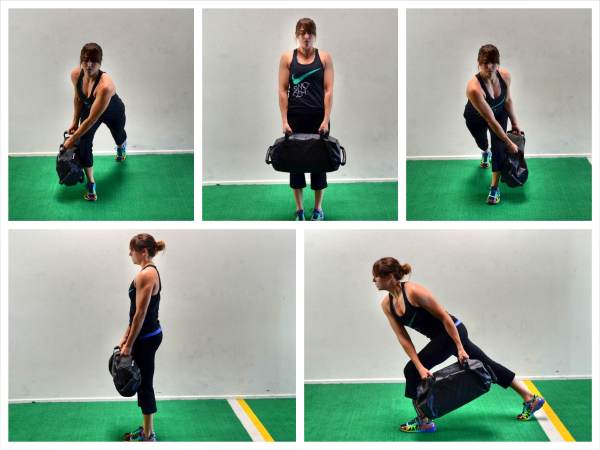
To do the Lunge with Rotation, grab a handle of the sandbag in each hand so that your palms are facing toward each other. Stand nice and tall with your feet together and sandbag in front of your legs. Then step back with one foot into a nice deep straight-legged lunge, bending the front knee and loading the glute.
As you lunge back, hinge over and rotate the sandbag down outside the front knee. Do not round forward as you rotate with the sandbag. Make sure to keep your back flat.
Then come back up to standing, stomping the back foot forward to meet your other foot as you bring the sandbag back around front and stand up nice and tall. Squeeze your glutes as you come back to standing.
Then quickly lunge back on the other leg, letting the sandbag swing outside the front knee. To come back up to standing, again stomp the back foot up forward and stand up nice and tall.
You want to “stomp” to make sure you drive through your heels and full extend your hips every time you come back up to standing. There will be a little more weight in this move on the front foot than on the back foot. Your back foot is almost more for stability so that you can focus on the hinge and loading your glutes.
Advanced exercisers will want to use the momentum of their lunge to swing the sandbag from side to side quickly instead of just “placing” the sandbag outside their front leg as beginners will do. By placing the bag instead of swinging, beginners will have better balance and more control. The swing makes the move more challenging because it can throw you off balance.
Make sure you stay in control of the sandbag to prevent injury and over-rotation. Also make sure your back stays flat and your core is engaged the entire time.Do not round forward as your rotate with the bag.
2. Front-Loaded Sandbag Good Mornings – By front loading an exercise, you make your core have to work even harder to support the weight. When you front-load good mornings, you are not only working your abdominal region but also your entire backside.
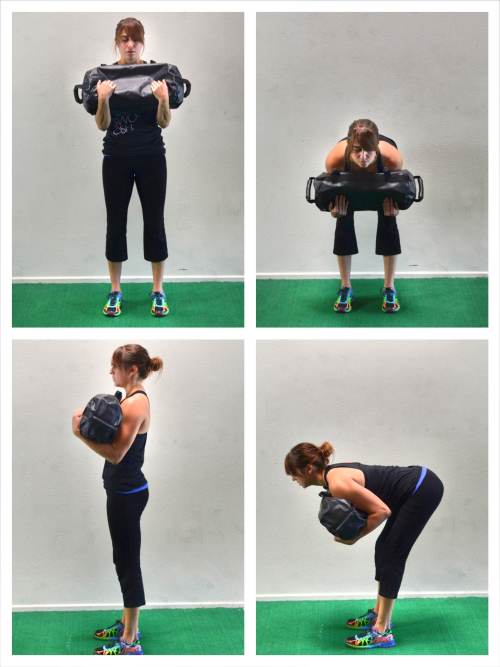
To do Front-Loaded Good Mornings, stand with your feet about hip-width apart and hold the sandbag up at your chest with your arms wrapped up around the bag.
Then hinge over keeping your back flat. As you hinge over, push your butt back and keep your knees soft. Feel a stretch down your hamstrings as you focus on pushing your butt back.
Do not rock forward as you hinge over or round your back. Make sure to sit back in your heels as you hinge over. To keep your low back from doing all the work, make sure to keep your back flat and core engaged. You do not want to feel this move in your low back.
Drive through your heels to come back up to standing and really squeeze your glutes at the top of the move. Make sure to keep the sandbag up at your chest the entire time.
You can change your stance to hit your legs from slightly different angles. To get your adductors more involved, widen your stance. To focus more on the glutes and hamstrings, keep your feet closer together.
Just make sure to keep your core engaged and feel a nice stretch down your hamstrings as you do the move. You want your butt and hamstrings to power the hinge not your low back.
3. Reverse Lunge With Slider – The Reverse Lunge with Slider is another great move to work your legs, glutes and core. And by adding in the slider and the Sandbag you are making the Basic Reverse Lunge super challenging. Beginners may want to start with the Basic Bodyweight Reverse Lunge and then add in only the sandbag or only the slider before using both together.
And while you can hold the sandbag up at your chest like you do with the Good Mornings, by placing the sandbag over only one shoulder, you force your core to work hard to stabilize to balance the unilateral (one-sided) load so that you don’t lean to one side.
When doing the Reverse Lunge with Slider, you make the movement a bit easier by putting the Sandbag over the shoulder of the standing leg and more challenging by loading down the leg moving with the slider.

To do the Reverse Lunge with Slider, place the sandbag over one shoulder and the slider under the ball of one foot. Stand up nice and tall and do not lean away or toward the side holding the sandbag.
Then slide the foot on the slider back and sink into a deep lunge, dropping your back knee down as close to the ground as possible. Keep your chest up as you lunge back and make sure to sit back in the heel of your front leg as you lunge back. You want to make sure to load the glute of the front leg.
Drive through the standing heel and pull the foot on the slider back forward as you come up to standing. Make sure you keep your chest up nice and tall and do not lean or round forward as you come back up to standing. Squeeze your glute at the top and then repeat, lunging back.
Do not lean to either side because of the unilateral load. Complete all reps on one side before switching.
4. Single Leg Deadlift With Slider – The Single Leg Deadlift with Slider is a great single leg deadlift variation especially for beginners because it still really works the glutes without being as hard to do because there is less balance required.
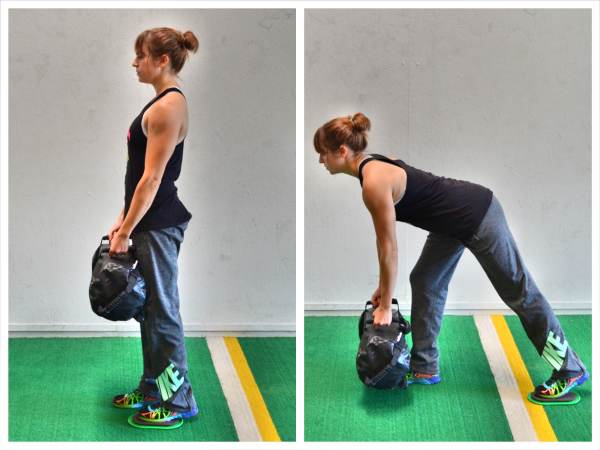
To do the Single Leg Deadlift with Slider, hold the sandbag down in front of your legs and place the ball of one foot on a slider. Stand nice and tall.
Then, hinging at the hips, slide the foot on the slider back. You want to feel a stretch down the hamstring of your standing leg as you sit back and load your glute. Lower the sandbag down toward the ground as you hinge over, but do not round your back.
Keep your back flat as you hinge over. Then driving through the standing foot, come back up to standing. Squeeze your glute as you come back up.
Hinge back over and repeat. Keep your abs braced as you hinge over so you don’t feel this move in your low back. Complete all reps on one side before switching the slider to the other foot.
5. Sandbag Single Leg Deadlift – This is a great unilateral exercise to work your posterior chain. And because each side works independently, it is a great move to correct imbalances since your dominate leg can’t take over.

To do the Sandbag Single Leg Deadlift, you can hold the sandbag in a couple of different ways. Beginners will want to hold the sandbag in both hands in front of them while more advanced exercisers may want to do a suitcase single leg deadlift, holding the sandbag in the opposite hand from the standing leg.
The Suitcase Single Leg Deadlift will force you to use your core more to prevent rotation. Whichever you do, use a weight that challenges you, but make sure that you brace your abs so that you don’t feel the move in your low back. Also, if you do the unilateral loading make sure your body stays in a nice straight line and don’t shift your weight to one side or the other.
To do the Basic Single Leg Deadlift, stand on one foot with the knee of that standing leg slightly bent.
Then hinge over at your hips, sweeping the other leg back toward the wall behind you while lowering the sandbag down toward the ground. Make sure to sit back as you hinge over and pretend you are driving the heel of the lifted foot straight into the wall behind you.
As you hinge over and sit your butt back, do not bend your standing knee and turn this into a squat. Also make sure to keep your back nice and flat. Make sure that as you hinge, you are sitting into the heel of your standing leg. Do not lean forward and come up onto your toes.
Come back up to standing by driving through the heel of your standing leg. Squeeze your glute and stand up nice and tall at the top of the move. Only tap the other foot down if you need to stabilize at the top. Do not tap your other foot down to help you come back up to standing. Only your standing leg should be working.
Complete all reps on one side before switching to the other leg.
6. Sandbag Zercher Squat – Another great compound leg movement is the Squat and just like with the Good Morning, by front-loading the Squat, you may the move even more core intensive.
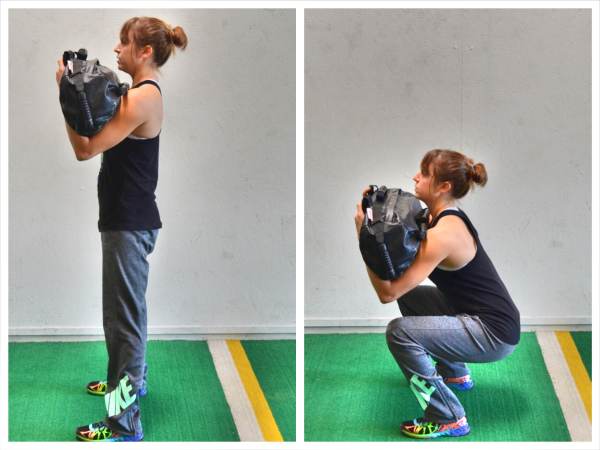
To do the Sandbag Zercher Squat, stand with your feet between hip-width and shoulder-width apart and hold the sandbag up at your chest with your arms wrapped around the bag. Do not let the sandbag sink down toward your belly button.
Keeping the bag up at your chest, squat down as low as possible, sitting your butt back and down while keeping your chest up. Make sure to sit back in your heels as you squat down. Do not come up onto your toes. Only go as low as you can with good form. Do not lean forward or let your back round.
Then drive back up to standing and squeeze your glutes at the top. Make sure to drive up through your heels and keep your chest up as you come to standing.
Brace your abs as you squat to support the sandbag. You do not want to feel this move in your low back.
7. Bear Hug Squat – If you struggle to keep your chest up and core tight when you do front squats, the Bear Hug Squat may be a good Squat Variation for you. Because of the way you hold the sandbag with this squat, it will make it easier to get low while keeping your chest up nice and tall and your abs engaged.
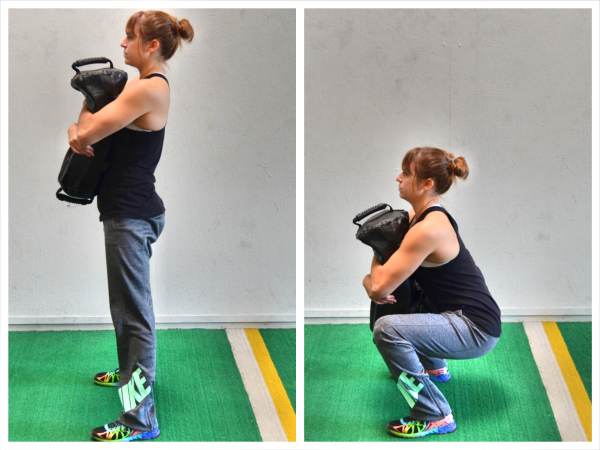
To do the Bear Hug Squat, turn the sandbag the long way and hug it in the middle, squeezing it tight in toward your chest. Your feet should be between hip-width and shoulder-width apart.
Keeping your chest up and the sandbag hugged tight, sit your butt back and down. Squat as low as you can and sit back in your heels. Do not let your back round forward. Make sure your heels stay down as you sink as low as possible.
Then drive straight back up, pushing through your heels. Squeeze your glutes at the top and stand up nice and tall, hugging the sandbag tight. Then sink back down.
Make sure your core stays tight the entire time. Do not shrug your shoulders as you hug the bag.
8. Bent-Over Row with Sandbag – This is a great exercise to work the big muscles of your while also engaging your entire core.
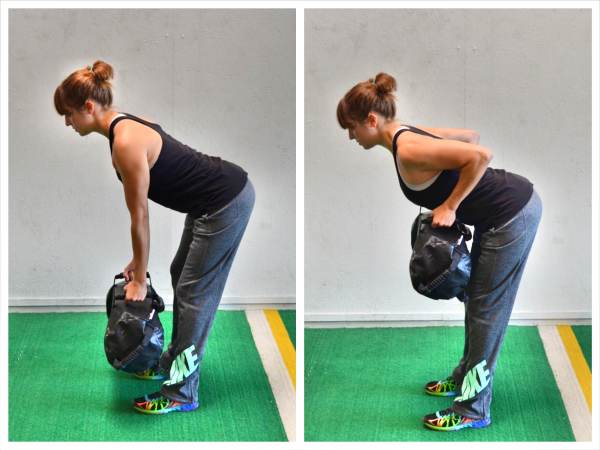
To do the Bent-Over Row with Sandbag, hold a handle of the sandbag in each hand. You can use a variety of grips (holding parallel or with your palms facing away or toward you).
Holding the sandbag straight down in front of you, bend your knees slightly and hinge over, keeping your back flat. Then row the sandbag up to your chest, driving your elbows down and back toward the ceiling. Do not curl your forearms up toward your chest as you row. You do not want this to turn into a bicep curl.
Make sure you feel your back pulling the weight up and not simply your arms curling the weight in. Also, make sure your back doesn’t round as you lift the weight.
Then lower the sandbag back down straightening your arms back out. Keep tension in your back and your back flat as you lower.
Do not use your legs to lift and lower the weight. Keep your core tight and your back still and flat as you row. You should not feel this move in your low back. If you do, you may be arching your back or you may need to bend your knees a bit.
9. Alternating Overhead Pressing – While many people have to be careful with overhead pressing because they lack shoulder and upper back mobility from sitting at a desk all day, the Sandbag Alternating Overhead Press is a great way to work the shoulders and core.

To do the Alternating Overhead Pressing, hold the sandbag around the middle of the bag with both hands. Place it over one shoulder with your feet about hip-width apart.
Then press the sandbag up and over your head to the other shoulder. Bring it down to that shoulder then press back over to the starting position.
Keep your core engaged so that you don’t feel this move in your low back. Maintain a nice tall posture throughout the movement.
If you want to make the move more explosive and not a strict press, you can get your legs involved.
To use your legs when doing the Alternating Overhead Pressing, bend your knees just slightly and quickly come back to standing as you press the sandbag overhead and up and over to the other shoulder. Lower it down to the other shoulder then quickly bend your knees and use your legs to press the sandbag back over to the side you started on. Press overhead from shoulder to shoulder as quickly as you can.
Do not turn the little knee bend into a full squat. You are just bending your knees enough to use your legs to help aid in the press. If you squat too low, it will turn into a squat and press instead of a push press.
10. Duck Under Lunge – In everyday life, we move in every direction. Therefore, as much as we can, we want to include exercises that work our body through numerous planes of motion. That is why the Duck Under Lunge is a great move to include. It will work on hip mobility and your triple extension (the extension of the ankle, knee and hip of that back leg when you pivot).

To do the Duck Under Lunge, hold the sandbag up at your chest with your arms wrapped around it like you did for the Zercher Squat.
You will then squat down, sitting your butt back while keeping your chest up. As you come back up out of the squat, you will rotate toward the right, pivoting your left foot. Stand up nice and tall, facing to the right with your back leg in triple extension. Do not let your foot stay put and your knee cave in.
Then rotate and sink back down into a squat and then pivot and rotate up toward the left side, pivoting your right foot. Keep your chest up the entire time. Do not let your back round toward the ground. Also do not lean forward to try to get lower to the ground.
Sink as low as you can in the squat without your form breaking down then quickly pivot up to each side.
As you get comfortable with the move, try to make it as fluid as possible. The move should look like a “U” shape.
Beginners may need to make it look more like a “V” until their hips open up more. Beginners may also need to drop the weight or not go as low.
11. Anti-Rotational Plank Pulls with Sandbag – This is a great core stability and strength move as well as a great move to work your lats. Because you are fighting the urge to rotate as you pull, this move is super shoulder and glute intensive and should be included to help strengthen your core to prevent injury.

To do the Anti-Rotational Sandbag Plank Pulls, set up in a plank position from your hands and toes or hands and knees and place the sandbag on the ground to one side of your body just outside and below your shoulder.
Make sure your hands are under your shoulders and then place your feet or knees wider apart to give you more stability. The closer together your feet are, the harder the move will be because you won’t have as wide or stable a base. If you feel your hips rocking side to side, widen your feet out. If the move is too easy, bring your feet closer together.
Then reach your hand under your body and across to grab the sandbag. Squeeze your glutes and, without rotating your hips, pull the sandbag through and across to the other side of your body. Make sure your body stays in a nice straight line with your abs engaged as you reach through and pull. Do not let your hips go up in the air or sag toward the ground.
You want to pull the sandbag all the way across and outside the other shoulder. If you can’t pull the sandbag all the way across or need to rotate your hips a lot to do so, it may be too heavy.
Then reach through with the other hand to pull it back.
To fight your body’s desire to rotate, you will need to engage your core and really squeeze your glutes. You do not want to feel this move in your low back.
Keep alternating reaches until all reps are complete. Your goal is to keep a nice straight line from your head to your heels the entire time.
12. Crawl With Sandbag Pull Through – The Crawl with Sandbag Pull Through is a cardio exercise that is also super core intensive and a great hip extension exercise. If you sit at a desk all day with your hips in flexion, this can be a great way to get your glutes firing. The move also really works your shoulders and even your back.

To do the Crawl with Sandbag Pull Through, place a sandbag on the ground and set up on your hands and knees with the sandbag behind your feet. Your hands should be under your shoulders and your knees should be under your hips.
Flex your feet and lift up onto your hands and toes. Then reach one hand back through your legs to grab the sandbag. As you reach back, sit your butt back toward your heels.
Then push off the balls of your feet and drive your hips forward to pull the sandbag up under your body and through overhead. As you pull the sandbag through, extend your hips to help you power the pull and extend your arm out in front of you. You don’t want to pull the sandbag through using only your arm.
Your hips should power the pull so that you can pull the sandbag up to your head or a little beyond.
Once you’ve pulled the sandbag, crawl up past the bag and then sit your butt back again and reach through with the other hand. Pull the sandbag up and through.
When you crawl, move opposite arm and leg together and keep your knees close to the ground. Do not let your butt go way up in the air.
Keep crawling and pulling the bag until the reps, distance or time have been completed. Use a heavy enough bag that you feel challenged. If it doesn’t force you to use your glutes and legs, the weight is too light. You shouldn’t be able to throw the bag 10 feet out in front of you, but you should be able to pull it past your head.
Beginners may need to start with a basic crawl without the sandbag or even a crawl from their knees.
13. Sandbag Halos – This is a great core, and especially, shoulder move; however, it is a more challenging movement to get down and beginners may want to start with a Kettlebell Halo shown in this post 10 Great Kettlebell Exercises.
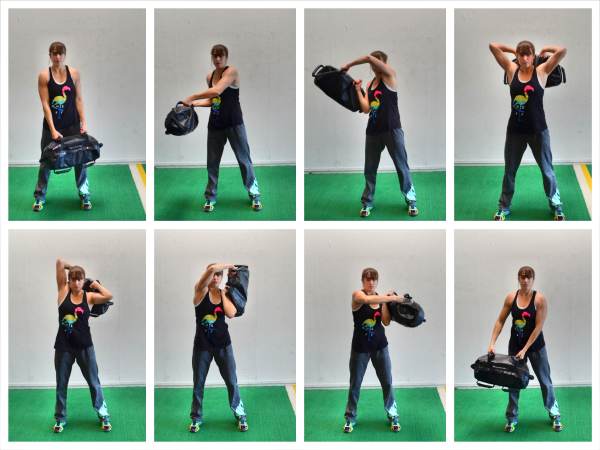
To do the Sandbag Halo, hold the bag either on both sides or with the handles that allow you to have your palms facing you. Stand with your feet about hip-width to shoulder-width apart and the bag hanging straight down in front of you with your arms straight.
Then pull it up to one hip and toward the side of your body. Once you get to the side of your body, start to pull the bag up and back. You are going to pull the bag in a big circle around your upper body and head.
You will pull up from one hip, toward the outside of your shoulder and then back around behind your head and shoulders before bringing it back outside the other shoulder and around front to your hips.
You can either than repeat the same circle or switch and go the other direction, bringing it up toward the other hip, outside the shoulder and back around your head and shoulders before returning it back around front.
Use your core and hips to stabilize and help you swing the sandbag. Squeeze your glutes and keep your core tight as you swing the bag to prevent injury.
Keep your head still as you circle and do as big a circle as your shoulders allow. You can use your hips a bit more to help you rotate as the bag gets heavier, but make sure to keep your core tight so that you don’t feel this in your low back.
3 Sandbag Workouts
Using the 13 Moves above, you can get in a ton of great full-body workouts. Below are three great free workouts and two great Elite Workout Library workouts to try using the Sandbag (a couple of which even have a few more new moves!)
- The Sandbag Metabolic Workout
- The Sandbag Core Workout
- The Sandbag Squat Workout
- The 30-Minute Full-Body Sandbag Workout (Members Only!)
- The Sandbag Glute Workout (Members Only!)
Looking for a Sandbag? We use the Ultimate Sandbag and like it because it is durable and has the variety of handles we need for our workouts!




Why it help you sandbag
Why use sandbags? There are many different reasons. You have to pick the equipment that will help you reach your goals. They are great for building stability and for improving everyday functional strength!
this exercises will hurt your lumber spine if done incorrectly
Any move done incorrectly can cause injury. Picking up a pencil off the ground in your car can lead to injury if you’ve created improper movement patterns and overload. These moves when done CORRECTLY can actually help you prevent lower back aches and pains.
Hey Cori,
I’ve seen a lot of other instructors do a rotational deadlift with a sandbag. It doesn’t seem to make sense to me. Any thoughts on how to do that exercise?
I’ve used it in a few youtube videos. I think it is a great but advanced movement. 🙂